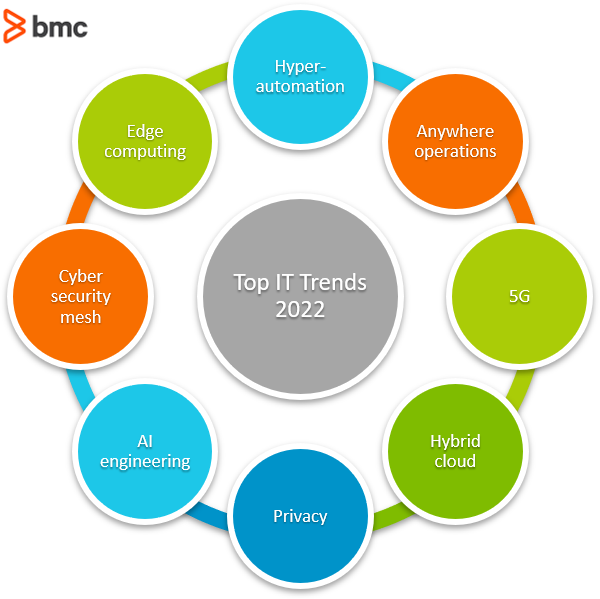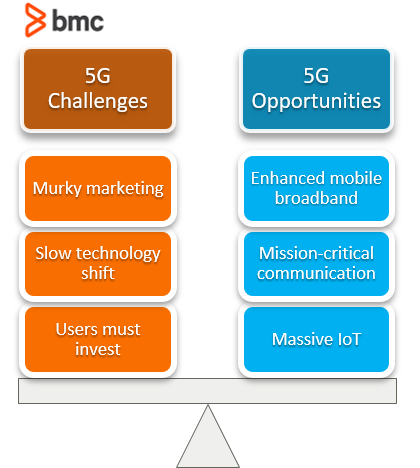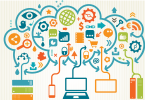After facing 2020, the year that upended life and business as we know it, 2021 was the year of pivoting and picking up the pieces of what the pandemic left behind. It wasn’t back to life as usual, however, as organizations and workers alike found that many pre-pandemic systems would never again be the same.
Looking ahead to 2022, there are a variety of trends that have come about as a result of the pandemic, and some that have stayed around because of it. Included in these is remote work, cloud usage, and new cybersecurity measures.
How can tech professionals keep up with it all? How do companies separate the buzzwords from the enduring changes that will radically alter business processes and industry standards? We have put together some of the top technology trends of 2022 that are sure to be on the top of industry leader’s minds and priority lists.

Top IT Trends 2022
Hyperautomation
Hyperautomation is nothing new; in fact, it was one of the top trends of 2021. What continues to change about hyperautomation, however, is its adoption and evolution.
“We’ve seen tremendous demand for automating repetitive manual processes and tasks; so robotic process automation was the star technology that companies were focused on to do that,” said Brian Burke, research vice president at Gartner.
“That has been happening for a couple of years, but what we’re seeing now is that it’s moved from task-based automation, to process-based automation, so automating a number of tasks in a process, to functional automation across multiple processes and even moving towards automation at the business ecosystem level. So really, the breadth of automation has expanded as we go forward with hyperautomation.”
(Compare automation with orchestration.)
Hyperautomation in 2022 will combine technologies like Robotic Process Automation (RPA), Artificial Intelligence (AI), and Machine Learning (ML) to process information in more impactful ways, improving quality and increasing overall productivity. Hyperautomation will also offer real-time, continuous intelligence with improved analytics to further enhance operations and processes.
Anywhere operations
One thing that has become certain over the past few years is that the way we work has changed forever. IT professionals in the United States saw a dramatic shift when COVID-19 forced as many as two-thirds of employees to work remotely.
Although these numbers are decreasing, there is still a large percentage of employees working from home. With this, organizations will need to incorporate technologies that enable seamless collaboration regardless of location. Enter in: anywhere operations.
Anywhere operations refers to an IT operating model that:
- Enables employees to work from anywhere
- Supports the deployment of business services across a distributed infrastructure
- Works well with mobile devices, which is highly beneficial to customers
Whether services need to be available on a desktop computer, tablet, mobile phone, or other device, giant corporations are beginning to catch on in the services they must adopt or offer.
The opportunities for organizations are endless, with needed technologies ranging from intelligent cameras and collaboration systems equipped with AI for conference calls, to entire platforms of software and infrastructure ecosystems that provide teams a digital headquarters.
5G
The demand for high-speed internet and smart home and city systems has pushed the development and adoption of 5G technologies for organizations. 5G has been long anticipated but 2021 was the first year the latest cellular technology was widespread.
In 2022, large enterprises as well as small start-ups will begin to create innovative infrastructures and applications in order to:
- Increase employee productivity
- Transform the customer experience
- Create new jobs
- Support mission-critical communications
- Provide massive IoT opportunities
5G is quickly becoming the network of choice for forward-thinking companies, largely due to its reliability and performance. In fact, the Global 5G Infrastructure Market size was valued at USD 1179.2 million in 2021 and is expected to reach USD 131.40 billion by 2030, with a growing CAGR of 68.83% from 2021-2030. Enterprise-use is only just beginning, with reports estimating that 5G will drive long-term secular growth.

5G opportunities and Challenges
Hybrid cloud
While the cloud is not an innovative trend by any means, simply using the cloud is no longer enough. Businesses must evolve and utilize different types of clouds in order to gain the most benefits from it. 2022 will be the year of the hybrid cloud, with vendors competing for the perfect mix of public and private clouds as organizations face challenges of data access and security.
Results from the 2021 Accelerate State of DevOps survey found that teams who used hybrid or multi-cloud software deployments were 1.6 times more likely to meet their organizational performance targets than those who used more traditional cloud strategies.
Companies that turn to more than one public cloud for solving business needs and challenges will become the norm, and as the year progresses it might even become a necessity. With data being created exponentially faster than ever before, and at the edge, this will only push the need to migrate.
(Read more about cloud growth, trends & stats.)
Privacy-enhancing computation
As legislation for global data protection matures, privacy will become increasingly important, furthering the need for privacy-enhancing computation. Privacy-enhancing computation will protect data in use while also maintaining its privacy and secrecy, exceptionally critical in:
- Multi-party data analytics use cases
- Untrusted environments
The actual number of organizations that will end up utilizing privacy-enhancing computation, however, is challenging to predict, according to Burke:
“That’s a difficult one to gauge because what we’ve seen over the years of course, is that a lot of organizations have not focused as much attention as they probably require on privacy. But we think that what’s happening now is that privacy legislation globally is really starting to take hold.”
And consumers are starting to notice. With the massive amounts of data users volunteer to apps and social media sites, questions are being raised as to what happens to this data and why it is being collected. Organizations will need to find new sources of data and be honest in its management in order to obtain the same level of customer experience.
(Understand the ethics of enterprise data.)
AI engineering
Each day, the world creates roughly 2.5 quintillion bytes of data, and that number is only continuing to increase at an exponential rate. The use of that data, however, is only as good as the systems put in place to manage, regulate, and evaluate it. This enormous task is nearly impossible to be performed manually by workers, instead companies have been turning to artificial intelligence (AI).
Even though AI has been mainstream in the tech world for years, the concept of AI engineering is proving to be a revolutionary new trend. AI engineering provides organizations with better direction in their AI projects, as close to half of these never make it out of the prototype stage to production.
“AI engineering is about providing a sort of engineering discipline, a robust structure that will emphasize having AI projects that are delivered in a consistent way to ensure that they can scale, move into production, all of those kinds of things. So it’s really bringing the engineering discipline to AI for end-user organizations. When you talk about large vendors, yes, they’ve been delivering successfully for the past quite a few years, but end-user organizations are needing to move out of the experimental stage with AI and move into a robust delivery model,” Burke said.
Developing an explicit AI engineering process will be key to success, incorporating elements of DevOps, ModelOps, and DataOps. This robust strategy will:
- Help projects reach development
- Improve the scalability, performance, and reliability of AI models in general
- Increase ROI
Cybersecurity mesh
With more employees working remotely and the cloud becoming the norm, it is imperative that businesses begin adopting new approaches to their network security. A mechanism that will be seen more often this upcoming year is cybersecurity mesh.
Cybersecurity mesh is a distributed architectural approach that provides flexibility, scalability, and reliability to cyber controls. Cybersecurity mesh essentially allows businesses to decouple policy decision making from policy enforcement: a cybersecurity mesh puts security perimeters around individuals—instead of just around the organization.
Utilizing this mesh technology, organizations will be better able to protect data and information, including what’s inside the facility walls, as well as everything that’s on the outside.
Edge computing
Edge computing is closely tied to IoT—it is the compute power that connects a variety of devices to bring users a mix of services and products that are more customizable and personal. Edge isn’t limited to personal use, though. Companies can expect edge computing to improve:
- Predictive maintenance
- Fleet and product management
- Voice assistance
(Learn more about the empowered edge & edge AI.)
Technology trends in 2022
In 2022, COVID-19 will continue to impact the way companies do business, and the way employees work. As we see accelerated uses of digitization and virtualization, the need for cloud, security, privacy, and automation will increase. True transformation is possible, and these trends will push many businesses forward into the future of tech.
Related reading
Explore our roundups of trends in other tech areas:
- IT Spending Trends
- IT Budget Trends
- IT Operations Trends
- DevOps Trends
- IT Automation Trends
- Digital Transformation Trends
- SaaS Growth Trends
- Cloud Growth Trends
- IT Salary Trends
These postings are my own and do not necessarily represent BMC's position, strategies, or opinion.
See an error or have a suggestion? Please let us know by emailing [email protected].






